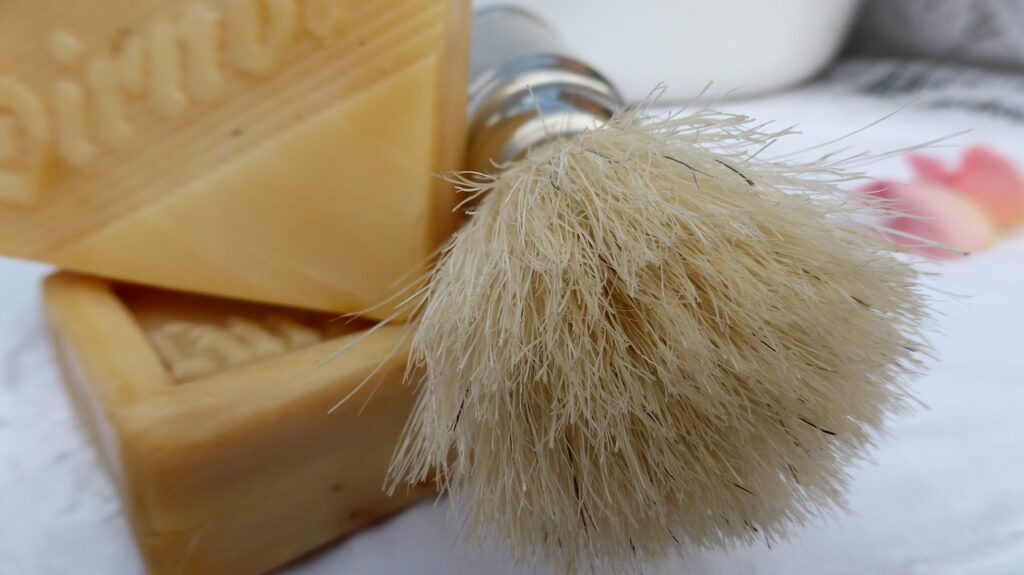So, you’ve decided to embark on a journey of growing a 3-month beard, huh? Well, buckle up because this article is about to become your go-to guide on how to achieve and maintain that luscious facial hair. Whether you’re a beard novice or a seasoned pro, we’ve got you covered with tips and tricks that will help you go from stubble to a full-on mane. From styling techniques to grooming routines, we’ll walk you through every step of the way, ensuring that your 3-month beard becomes the envy of every man around. Get ready to embrace your bearded awesomeness!
Setting a Goal
Growing a beard requires setting a goal. It’s important to decide on the length you want to achieve before embarking on your beard-growing journey. Whether you’re aiming for a short beard or a long, flowing one, having a clear goal will help you stay motivated throughout the process.

Decide on the Length
When setting a goal for your beard, consider the length that suits your face shape and personal style. Some men prefer a shorter beard that is easier to manage and maintain, while others aim for a majestic, full-grown beard. Take into account your facial features and the overall look you want to achieve to determine the ideal length for your beard.
Consider Your Facial Hair Growth Rate
It’s essential to be realistic about your facial hair growth rate when setting a beard goal. Some men’s facial hair grows at a rapid pace, allowing them to achieve their desired beard length within a relatively short period. However, others may have slower hair growth, requiring more time and patience to reach their desired beard length. Understanding your hair growth rate will help you manage your expectations and adjust your grooming routine accordingly.
Commitment and Patience
Growing a beard takes commitment and patience. It may take several weeks or even months to achieve the desired length and fullness. During this time, you’ll need to resist the temptation to give up and shave off your facial hair prematurely. Stay motivated by keeping your end goal in mind and reminding yourself of the rewarding outcome awaiting you. Remember, growing a beard is a journey that requires dedication and time.
Start with a Clean Slate
Before you dive into your beard-growing journey, it’s crucial to start with a clean slate. Preparing your facial hair and skin will set the foundation for a healthy beard growth process.
Trim Your Beard
If you already have some facial hair, it’s a good idea to trim it before starting to grow your beard. Trimming your existing beard will help you achieve an even length, making it easier to grow out evenly. Use a quality trimmer and set it to your desired length, trimming away any uneven or excessive growth.
Shave off Existing Facial Hair
If you don’t currently have any facial hair, make sure to shave off any existing stubble or stray hairs. Starting with a clean-shaven face will allow your beard to grow out uniformly and avoid any patchy or uneven growth patterns.
Cleanse and Exfoliate Your Skin
Once your face is clean-shaven, it’s essential to cleanse and exfoliate your skin regularly. Use a mild facial cleanser to remove dirt, oil, and dead skin cells from your face. Exfoliating your skin a few times a week will help prevent ingrown hairs and promote healthier beard growth.
Proper Beard Care Routine
To maintain a healthy and well-groomed beard, it’s crucial to establish a proper beard care routine. This routine should include regular washing, moisturizing, conditioning, and the application of beard oil.
Regularly Wash Your Beard
Washing your beard with a gentle beard shampoo is an essential part of beard care. Regular washing removes dirt, grime, and excess oils that can accumulate in your facial hair, keeping your beard clean and fresh. Be sure to rinse thoroughly and pat your beard dry with a clean towel after each wash.
Moisturize Your Beard
Just like the hair on your head, your beard needs moisture to stay healthy and soft. Applying a beard moisturizer or beard oil after washing your beard will help keep it hydrated and prevent dryness or flakiness. Massage the moisturizer or oil into your beard and the underlying skin to ensure proper absorption.
Condition Your Beard
Conditioning your beard is an integral part of maintaining its health and appearance. Use a high-quality beard conditioner to nourish your facial hair, making it softer, more manageable, and less prone to breakage or split ends. Apply the conditioner after washing your beard and leave it on for a few minutes before rinsing thoroughly.
Beard Oil Application
Beard oil is a game-changer when it comes to caring for your beard. It provides essential nutrients, moisturizes the skin beneath your beard, and adds shine and luster to your facial hair. Use a few drops of beard oil and work it through your beard with your fingers, making sure to reach the roots for maximum benefits.
Healthy Lifestyle Habits
In addition to a proper beard care routine, maintaining a healthy lifestyle is crucial for optimal beard growth and overall well-being. Certain habits contribute to healthier hair growth, including a balanced diet, hydration, sufficient sleep, and regular exercise.

Maintain a Balanced Diet
What you eat plays a significant role in the health and growth of your beard. Ensure your diet includes foods rich in vitamins, minerals, and proteins, such as lean meats, fruits, vegetables, nuts, and seeds. These nutrients promote hair growth and strengthen your facial hair, helping you achieve a fuller, healthier beard.
Stay Hydrated
Drinking an adequate amount of water is essential for maintaining proper hydration, including your beard. Water helps transport nutrients to the hair follicles, promoting healthy growth and preventing dryness. Aim to drink at least eight glasses of water per day to keep yourself and your beard hydrated.
Get Enough Sleep
Adequate sleep is crucial for overall health, including hair growth. Lack of sleep can disrupt hormone levels, affecting the growth cycle of your hair. Aim for seven to nine hours of quality sleep each night to support healthy beard growth and overall well-being.
Exercise Regularly
Regular exercise not only benefits your physical health but also promotes hair growth. Exercise improves blood circulation, delivering essential nutrients to your hair follicles and promoting healthy hair growth. Aim for at least 30 minutes of moderate-intensity exercise, such as brisk walking or jogging, on most days of the week.
Combat Itchiness and Irritation
As your beard grows, you may experience itchiness and irritation, especially during the initial stages. Fortunately, there are measures you can take to alleviate these discomforts and ensure a smooth beard-growing journey.
Use Beard Shampoo and Conditioner
Using a specialized beard shampoo and conditioner can help alleviate itchiness and irritation. These products are designed to be gentle on the skin while effectively cleansing and conditioning your facial hair. Incorporate them into your regular beard care routine to keep your beard clean and hydrated.

Apply Beard Oil
Beard oil not only moisturizes your facial hair but also soothes the underlying skin, reducing itchiness and irritation. The nourishing ingredients in beard oil help prevent dryness and flaking, providing relief and comfort during the beard-growing process. Apply beard oil daily, focusing on the skin beneath your beard for maximum effectiveness.
Avoid Scratching or Plucking
Resist the temptation to scratch or pluck at your beard, as it can exacerbate itchiness and irritation. Scratching can damage the skin and cause redness, while plucking can disrupt the natural growth pattern of your beard. Instead, use beard oil or a soft-bristled brush to alleviate any discomfort.
Exfoliate and Moisturize
Exfoliating your skin regularly can help remove dead skin cells and prevent clogged hair follicles, reducing itchiness and promoting healthier beard growth. Use a gentle exfoliating scrub specifically designed for facial use. After exfoliating, moisturize your skin with a beard moisturizer or oil to maintain hydration and prevent dryness.
Appropriate Grooming Techniques
To maintain a well-groomed beard, it’s important to adopt appropriate grooming techniques. Regular trimming, brushing, and the use of grooming products like beard balm or wax can help you achieve the desired shape and a polished look.
Regularly Trim and Shape Your Beard
Regular trimming and shaping are essential for maintaining a well-groomed beard. Invest in a quality beard trimmer and regularly trim the excess length or uneven growth to achieve your desired style. Utilize the trimmer’s attachments to shape your beard, whether it’s a classic full beard, a goatee, or a stylish mustache.
Brush and Comb Your Beard
Brushing and combing your beard daily can help distribute natural oils, prevent tangling, and promote healthier hair growth. Use a beard brush or comb with wide teeth to detangle your facial hair gently. Start from the roots and work your way down, ensuring that every strand is adequately cared for.

Use Beard Balm or Wax
If you prefer a more styled beard, beard balm or wax can be your best friend. These grooming products provide shape and hold, allowing you to sculpt your beard into your desired style. Apply a small amount of balm or wax to your fingertips and work it through your beard, shaping and sculpting as you go.
Professional Grooming
If you’re unsure about grooming techniques or want to achieve a specific beard style, consider seeking professional help. Barbers and stylists experienced in beard grooming can offer expert advice, trim and shape your beard, and recommend the best products and techniques for your beard type and style. A trip to the barber can give you the confidence and knowledge you need to maintain your beard at home.
Avoid Beard Patchiness
Beard patchiness, where certain areas of the beard appear less dense than others, can be a common concern for many men. While genetics and age play a role in beard growth patterns, several techniques can help address this issue and maintain a healthy-looking beard.
Combat Genetics and Age
Genetics and age are factors that can influence beard growth patterns and might contribute to patchiness. While these factors are beyond control, maintaining a healthy beard care routine coupled with appropriate grooming techniques can minimize the appearance of patchiness and promote healthier beard growth.
Consider Facial Hair Transplant
For those seeking a more permanent solution to patchiness, facial hair transplant surgery may be an option. This procedure involves harvesting healthy hair follicles from other parts of the body and transplanting them to the patchy areas of the beard. However, it’s essential to consult with a qualified professional to determine if this is the right choice for you.
Beard Filling Techniques
Temporary techniques, such as beard filler products, can help fill in patchy areas and create the appearance of a fuller beard. These products are typically in the form of powders, creams, or sprays that match your beard color and can be applied to sparse areas to create the illusion of density. Experiment with different products and techniques to find the one that suits you best.

Maintain a Healthy Beard
Taking care of your beard through proper grooming and regular maintenance can make a significant difference in minimizing the appearance of patchiness. By keeping your facial hair healthy, conditioned, and well-groomed, you can enhance its overall appearance and maximize its potential.
Maintaining Beard Hygiene
Proper beard hygiene is crucial to maintain a clean and healthy beard. By following a few hygiene practices, you can keep your beard fresh, free from dandruff, and in optimum condition.
Avoid Touching Your Beard
Throughout the day, it’s easy to unconsciously touch or stroke your beard. However, this habit can introduce dirt, oils, and bacteria from your hands into your facial hair, leading to potential hygiene issues. Train yourself to avoid touching or playing with your beard to minimize contamination.
Clean Your Beard Regularly
Regular cleansing is essential to keep your beard clean and free from dirt, oil, and impurities. Use a beard shampoo or a mild facial cleanser specifically designed for facial hair. Gently massage the cleanser into your beard, ensuring thorough coverage, and rinse off with water. Regular cleansing will contribute to a healthy and hygienic beard.
Keep Your Beard Fresh
To maintain a fresh-smelling beard, it’s essential to eliminate any unwanted odors that may accumulate. Use a beard-specific deodorizing spray or fragrance-free beard oil to keep your beard smelling pleasant. Be cautious with scented products, as some fragrances can irritate the skin or overpower your natural scent.
Address Beard Dandruff
Beard dandruff, also known as beardruff, can occur due to dry skin, product buildup, or a lack of proper cleansing. To address this issue, use a beard shampoo that’s specifically formulated to combat dandruff. Incorporate gentle exfoliation into your routine to remove dead skin cells, and regularly moisturize your beard and the underlying skin to prevent dryness and flaking.
Overcoming Beard Growth Obstacles
Sometimes, achieving the desired beard growth can be challenging due to various factors. Slow growth, genetic factors, hormonal imbalances, or other obstacles may hinder the progress. However, there are several strategies you can employ to overcome these obstacles and stimulate beard growth.
Dealing with Slow Beard Growth
Having a slow beard growth rate can be frustrating, but patience is key. To stimulate beard growth, try increasing blood circulation in the face by massaging the skin daily. Additionally, maintaining a healthy lifestyle, incorporating necessary nutrients, and practicing stress reduction techniques can help optimize beard growth.
Genetic Factors
Genetics plays a significant role in determining your beard’s growth pattern and density. If your genetics predispose you to patchiness or slow growth, it may require more effort and patience to achieve your desired beard. Focus on maintaining a healthy beard care routine and grooming practices to make the most out of your genetics.
Hormonal Imbalances
Imbalances in hormone levels, such as low testosterone, can affect beard growth. If you suspect hormonal imbalances may be hindering your beard growth, consult with a healthcare professional or endocrinologist who can evaluate your hormone levels and recommend appropriate treatments or lifestyle changes.
Beard Growth Supplements
If you’re struggling to achieve the desired beard growth, you may consider trying beard growth supplements. These supplements typically contain vitamins, minerals, and herbal extracts that support healthy hair growth. However, it’s essential to consult with a healthcare professional before starting any new supplement regimen to ensure it is safe and suitable for your needs.
Seeking Assistance from Professionals
When faced with challenges or uncertainties during your beard-growing journey, seeking assistance from professionals can provide valuable guidance and support. Dermatologists, barbers, and online beard communities can offer advice, expertise, and a sense of community to help you navigate through any obstacles.
Consult a Dermatologist
If you experience persistent issues with your beard, such as excessive itching, rashes, or unusual hair loss, it’s advisable to consult a dermatologist. These medical professionals specialize in skin and hair health and can help diagnose and address any underlying issues that may be affecting your beard growth. They can provide personalized advice and appropriate treatments tailored to your specific needs.
Visit a Barber
Barbers are experts in men’s grooming, including beard care and styling. Schedule regular visits to a trusted barber who can provide professional advice, trim and shape your beard, and ensure it looks its best. They can guide you on suitable grooming techniques, recommend products, and keep your beard looking sharp and well-maintained.
Join Beard Support Groups
Online beard support groups and communities can be valuable resources for sharing experiences, seeking advice, and finding support from fellow beard enthusiasts. These communities often host discussions, offer tips and tricks, and provide a space for camaraderie and inspiration as you navigate your beard-growing journey.
Follow Online Beard Communities
Follow influential beard enthusiasts and grooming experts on social media platforms to gain insights, tips, and inspiration for your beard-growing and grooming routine. Many experts share valuable information, tutorials, and product recommendations through their online presence. Engaging with these communities can enrich your knowledge and help you stay motivated and informed throughout your beard-growing journey.
Growing and maintaining a 3-month beard requires dedication, patience, and proper care. By setting a goal, practicing good grooming habits, adopting a healthy lifestyle, and seeking professional guidance when needed, you can achieve a full and healthy beard that enhances your appearance and boosts your confidence. Embrace the journey, enjoy the process, and let your beard be a manifestation of your individuality and style.
